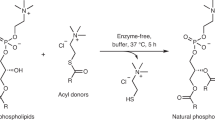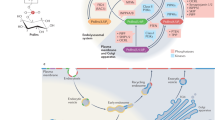Abstract
In low-phosphorus (P) marine systems, phytoplankton replace membrane phospholipids with non-phosphorus lipids, but it is not known how rapidly this substitution occurs. Here, when cells of the model diatom Thalassiosira pseudonana were transferred from P-replete medium to P-free medium, the phospholipid content of the cells rapidly declined within 48 h from 45±0.9 to 21±4.5% of the total membrane lipids; the difference was made up by non-phosphorus lipids. Conversely, when P-limited T. pseudonana were resupplied with P, cells reduced the percentage of their total membrane lipids contributed by a non-phosphorus lipid from 43±1.5 to 7.3±0.9% within 24 h, whereas the contribution by phospholipids rose from 2.2±0.1 to 44±3%. This dynamic phospholipid reservoir contained sufficient P to synthesize multiple haploid genomes, suggesting that phospholipid turnover could be an important P source for cells. Field observations of phytoplankton lipid content may thus reflect short-term changes in P supply and cellular physiology, rather than simply long-term adjustment to the environment.
Similar content being viewed by others
Log in or create a free account to read this content
Gain free access to this article, as well as selected content from this journal and more on nature.com
or
References
Benning C, Huang ZH, Gage DA . (1995). Accumulation of a novel glycolipid and a betaine lipid in cells of Rhodobacter sphaeroides grown under phosphate limitation. Arch Biochem Biophys 317: 103–111.
Birner R, Daum G . (2003). Biogenesis and cellular dynamics of aminoglycerophospholipids. Int Rev Cytol 225: 273–323.
Karl D, Letelier R, Tupas L, Dore J, Christian J, Hebel D . (1997). The role of nitrogen fixation in biogeochemical cycling in the subtropical North Pacific Ocean. Nature 388: 533–538.
Krom MD, Kress N, Brenner S, Gordon LI . (1991). Phosphorus limitation of primary productivity in the Eastern Mediterranean Sea. Limnol Oceanogr 36: 424–432.
Minnikin DE, Abdolrahimzadeh H, Baddiley J . (1974). Replacement of acidic phospholipids by acidic glycolipids in Pseudomonas diminuta. Nature 249: 268–269.
Riekhof WR, Andre C, Benning C . (2005). Two enzymes, BtaA and BtaB, are sufficient for betaine lipid biosynthesis in bacteria. Arch Biochem Biophys 441: 96–105.
Tjellström H, Andersson MX, Larsson KE, Sandelius AS . (2008). Membrane phospholipids as a phosphate reserve: the dynamic nature of phospholipid-to-digalactosyl diacylglycerol exchange in higher plants. Plant Cell Environ 31: 1388–1398.
Twining BS, Nuñez-Milland D, Vogt S, Johnson RS, Sedwick PN . (2010). Variations in Synechococcus cell quotas of phosphorus, sulfur, manganese, iron, nickel, and zinc within mesoscale eddies in the Sargasso Sea. Limnol Oceanogr 55: 492–506.
Van Mooy BAS, Fredericks HF . (2010). Bacterial and eukaryotic intact polar lipids in the eastern subtropical South Pacific: water-column distribution, planktonic sources, and fatty acid composition. Geochim Cosmochim Acta 74: 6499–6516.
Van Mooy BAS, Fredricks HF, Pedler BE, Dyhrman ST, Karl DM, Koblížek M et al. (2009). Phytoplankton in the ocean use non-phosphorus lipids in response to phosphorus scarcity. Nature 458: 69–72.
Van Mooy BAS, Rocap G, Fredricks HF, Evans CT, Devol AH . (2006). Sulfolipids dramatically decrease phosphorus demand by picocyanobacteria in oligotrophic marine environments. Proc Natl Acad Sci USA 103: 8607–8612.
von Dassow P, Petersen TW, Chepurnov VA, Armbrust EV . (2008). Inter- and intraspecific relationships between nuclear DNA content and cell size in selected members of the centric diatom genus Thalassiosira (Bacillariophyceae). J Phycol 44: 335–349.
Wu JF, Sunda W, Boyle EA, Karl DM . (2000). Phosphate depletion in the western North Atlantic Ocean. Science 289: 759–762.
Zavaleta-Pastor M, Sohlenkamp C, Gao JL, Ziqiang G, Zaheer R, Finan TM et al. (2010). Sinorhizobium meliloti phospholipase C required for lipid remodeling during phosphorus limitation. Proc Natl Acad Sci USA 107: 302–307.
Acknowledgements
We thank Helen Fredericks for help with chromatography and mass spectrometry, and two anonymous reviewers for constructive criticism. This research was funded by NSF OCE-0646944 and OCE-1045670 (BVM), OCE-0723677 and OCE-0549794 (STD), and by the Graduate School, National Oceanography Centre, Southampton (PM).
Author information
Authors and Affiliations
Corresponding author
Additional information
Supplementary Information accompanies the paper on The ISME Journal website
Rights and permissions
About this article
Cite this article
Martin, P., Van Mooy, B., Heithoff, A. et al. Phosphorus supply drives rapid turnover of membrane phospholipids in the diatom Thalassiosira pseudonana. ISME J 5, 1057–1060 (2011). https://doi.org/10.1038/ismej.2010.192
Received:
Revised:
Accepted:
Published:
Issue date:
DOI: https://doi.org/10.1038/ismej.2010.192
Keywords
This article is cited by
-
Changes in the membrane lipid composition of a Sulfurimonas species depend on the electron acceptor used for sulfur oxidation
ISME Communications (2022)
-
Morpho-physiological adaptations of Leptocylindrus aporus and L. hargravesii to phosphate limitation in the northern Adriatic
Scientific Reports (2022)
-
Abiotic stress in algae: response, signaling and transgenic approaches
Journal of Applied Phycology (2022)
-
Lipid bound phosphorus in the seston of Lake Erie and its tributaries and its use as an indicator of algal P-limitation
Aquatic Sciences (2021)
-
Metabolic response of Botryococcus braunii to high bicarbonate dosages and other conditions: analysis of photosynthetic performance, productivity, and lipidomic profile
Journal of Applied Phycology (2021)



